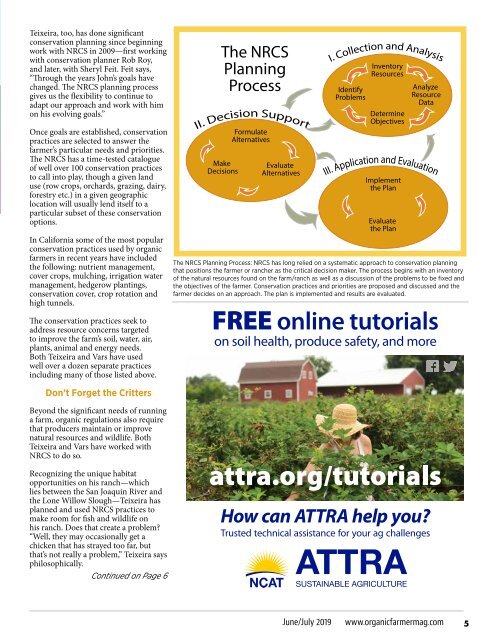Organic Farmer June 2019
Create successful ePaper yourself
Turn your PDF publications into a flip-book with our unique Google optimized e-Paper software.
Teixeira, too, has done significant<br />
conservation planning since beginning<br />
work with NRCS in 2009—first working<br />
with conservation planner Rob Roy,<br />
and later, with Sheryl Feit. Feit says,<br />
“Through the years John’s goals have<br />
changed. The NRCS planning process<br />
gives us the flexibility to continue to<br />
adapt our approach and work with him<br />
on his evolving goals.”<br />
Once goals are established, conservation<br />
practices are selected to answer the<br />
farmer’s particular needs and priorities.<br />
The NRCS has a time-tested catalogue<br />
of well over 100 conservation practices<br />
to call into play, though a given land<br />
use (row crops, orchards, grazing, dairy,<br />
forestry etc.) in a given geographic<br />
location will usually lend itself to a<br />
particular subset of these conservation<br />
options.<br />
In California some of the most popular<br />
conservation practices used by organic<br />
farmers in recent years have included<br />
the following: nutrient management,<br />
cover crops, mulching, irrigation water<br />
management, hedgerow plantings,<br />
conservation cover, crop rotation and<br />
high tunnels.<br />
The conservation practices seek to<br />
address resource concerns targeted<br />
to improve the farm’s soil, water, air,<br />
plants, animal and energy needs.<br />
Both Teixeira and Vars have used<br />
well over a dozen separate practices<br />
including many of those listed above.<br />
Don’t Forget the Critters<br />
Beyond the significant needs of running<br />
a farm, organic regulations also require<br />
that producers maintain or improve<br />
natural resources and wildlife. Both<br />
Teixeira and Vars have worked with<br />
NRCS to do so.<br />
The NRCS<br />
Planning<br />
Process<br />
Make<br />
Decisions<br />
Formulate<br />
Alternatives<br />
Evaluate<br />
Alternatives<br />
Identify<br />
Problems<br />
Inventory<br />
Resources<br />
Determine<br />
Objectives<br />
Implement<br />
the Plan<br />
Evaluate<br />
the Plan<br />
Analyze<br />
Resource<br />
Data<br />
The NRCS Planning Process: NRCS has long relied on a systematic approach to conservation planning<br />
that positions the farmer or rancher as the critical decision maker. The process begins with an inventory<br />
of the natural resources found on the farm/ranch as well as a discussion of the problems to be fixed and<br />
the objectives of the farmer. Conservation practices and priorities are proposed and discussed and the<br />
farmer decides on an approach. The plan is implemented and results are evaluated.<br />
FREE online tutorials<br />
on soil health, produce safety, and more<br />
Recognizing the unique habitat<br />
opportunities on his ranch—which<br />
lies between the San Joaquin River and<br />
the Lone Willow Slough—Teixeira has<br />
planned and used NRCS practices to<br />
make room for fish and wildlife on<br />
his ranch. Does that create a problem?<br />
“Well, they may occasionally get a<br />
chicken that has strayed too far, but<br />
that’s not really a problem,” Teixeira says<br />
philosophically.<br />
Continued on Page 6<br />
How can ATTRA help you?<br />
Trusted technical assistance for your ag challenges<br />
<strong>June</strong>/July <strong>2019</strong><br />
www.organicfarmermag.com<br />
5


















